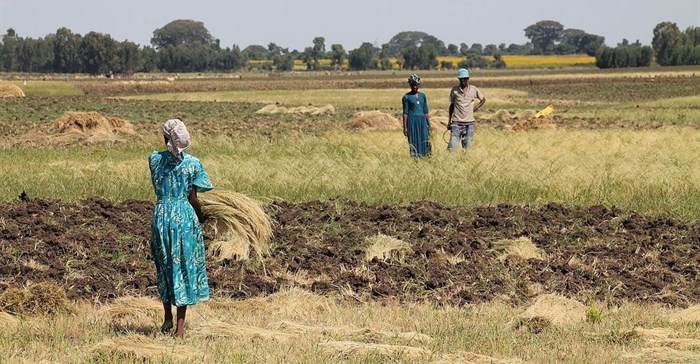
Top stories


EducationFrom adversity to opportunity: African education’s revival strategies
Sanjeev Mansotra 1 day



Marketing & MediaThe Odd Number named Financial Mail AdFocus Mid-Sized Agency of the Year
The Odd Number 1 day

More news












Jill Farrant, a biology professor at Cape Town University, hopes that by putting resurrection plants' survival skills into crops, making them drought-tolerant, the world's population could be better fed.

Farrant and her team are currently testing the technique on maize, but in theory, it could be applied to any crop, she said. "Give (the plants) water, and they are fully active within 24 to 48 hours," Farrant told the Thomson Reuters Foundation at her office.
Nearly 800 million people go to bed hungry each night, according to the United Nations, with drought one of the greatest threats to food production. In Southern Africa, more than 21 million people need emergency assistance due to a food crisis after the region's worst drought in 35 years and an infestation of the crop-damaging fall armyworm.
Farrant's research has shown that survival mechanisms found in the 135 varieties of resurrection plants, such as the 'Rose of Jericho' and 'Siempre Viva' desert plants, are similar to the desiccation processes found in crop seeds.
During a drought, a resurrection plant behaves like a seed, drying up and appearing to be dead, but then bursts back to life when rain finally falls. "Since all crops produce dry seeds, this implies that the genetic mechanisms for desiccation tolerance exist in crops," said Farrant.
The problem is the mechanism is not switched on, she said. By modifying the existing gene composition, Farrant and her team could potentially produce drought-tolerant crops. "By figuring out how they turn on these genes in roots and leaves, we can enable the same processes in leaves and roots of crops under drought conditions," Farrant said.
"Most of the genes responsible for desiccation tolerance are controlled by two master switches," she said, comparing the mechanisms to a household electronic circuit. By understanding how these switches are flipped in vegetative tissues of resurrection plants in response to water loss, Farrant is investigating how to enable the same reaction in crops.
Her first trial crops are maize, beans and an edible grass called teff, which accounts for two-thirds of the daily protein intake in hunger-stricken Ethiopia.

Mel Oliver, research leader of the US Department of Agriculture and professor of plant sciences at the University of Missouri, is also trying to find out how resurrection plants tolerate water loss and recover. "The genes are there, they're just not activated. If we understand how it works in resurrection plants, we can do it in crops," he said by phone.
David Orr, Southern Africa spokesman for the UN World Food Programme (WFP), said the research could bring benefits to drought-susceptible Southern Africa. "In a region where climate-related shocks are becoming more frequent and more intense, farming communities are having to contend with drought - and occasionally flooding - as a new reality," he said by email. "By having access to drought-resistant seeds and other agricultural technologies such as water harvesting and irrigation, they will be better equipped to face the future."
Farrant said the research could cost a total of 20 million euros ($21 million), adding that she needed more funds to continue her work.
Nick Vink, chair of the Department of Agricultural Economics at Stellenbosch University in Cape Town, said weighing up the costs versus the benefits of the research was a difficult calculation. "The potential benefit is really very high, while it is not easy to estimate what the probability of success is," he told the Thomson Reuters Foundation.
Chikelu Mba of the UN Food and Agricultural Organisation (FAO) in Rome was hesitant to evaluate the potential of such technologies before seeing evidence-based testing and the impact of modified crops on the environment. "You have to look at the effects of gene modification," he told the Thomson Reuters Foundation via Skype.
Small farmers growing maize - a crop that can produce bumper harvests but is susceptible to poor rainfall - may also be persuaded to switch to unmodified crops that are simply better able to resist drought, like beans, the FAO has said.
Farrant is confident that in time, she can deliver plants that are resistant to drought. "Five years, and I'll give you a resurrection plant that can provide crops," she said, adding that testing the drought-resistant crops might take a further five years.
"Then it is food on your plate, but it might be too long - people need food now."
($1 = 0.9492 euros)
Reporting by Peter Lykke Lind, editing by Ros Russell.
The Thomson Reuters Foundation is reporting on resilience as part of its work on zilient.org, an online platform building a global network of people interested in resilience, in partnership with the Rockefeller Foundation.

AllAfrica is a voice of, by and about Africa - aggregating, producing and distributing 2000 news and information items daily from over 130 African news organisations and our own reporters to an African and global public. We operate from Cape Town, Dakar, Lagos, Monrovia, Nairobi and Washington DC.
Go to: http://allafrica.com/